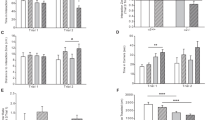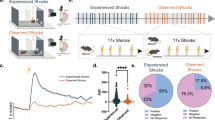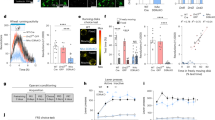Abstract
Safety signals (SSs) have been shown to reinforce instrumental avoidance behavior due to their ability to signal the absence of an aversive event; however, little is known of their neural mediation. This study investigated whether infusions of d-amphetamine in the nucleus accumbens (Nac), previously shown to potentiate responding for appetitive conditioned reinforcers (CRfs), also regulate avoidance responding for a SS. Rats were trained on a free-operant task in which lever-press responses avoided shock and were reinforced with an auditory SS. Rats were then cannulated in the Nac core (NacC) or shell (NacS) and infused with d-amphetamine and, in separate NacS groups, other drugs, before extinction sessions with the SS present or absent following responding. Selective effects of d-amphetamine were found in the NacS, but not in the NacC, when the SS was present in the session. A significant increase in response rate during the presentation of the SS reflected a disruption of its fear-inhibiting properties. In parallel, a decrease in avoidance response rate reflected the reduced influence of the SS as a CRf. Inactivation of the NacS reduced avoidance responding only when the SS was present in the session, whereas the D1–D2 DA receptor antagonist α-flupenthixol reduced responding both before and during the SS regardless of the presence of the SS. Atomoxetine (ATO), a selective noradrenaline reuptake inhibitor, had no effect on responding. These results indicate a role for the NacS in the mediation of the conditioned reinforcing properties of a SS. These effects appear to be modulated by dopaminergic mechanisms but seem distinct from those previously reported with food-related CRfs.
Similar content being viewed by others
Log in or create a free account to read this content
Gain free access to this article, as well as selected content from this journal and more on nature.com
or
References
Badrinarayan A, Wescott SA, Vander Weele CM, Saunders BT, Couturier BE, Maren S et al (2012). Aversive stimuli differentially modulate real-time dopamine transmission dynamics within the nucleus accumbens core and shell. J Neurosci 32: 15779–15790.
Bolles RC (1972). Reinforcement, expectancy, and learning. Psychol Rev 79: 394–409.
Boschen SL, Wietzikoski EC, Winn P, Da Cunha C (2011). The role of nucleus accumbens and dorsolateral striatal D2 receptors in active avoidance conditioning. Neurobiol Learn Memory 96: 254–262 doi:10.1016/j.nlm.2011.05.002.
Budygin EA, Park J, Bass CE, Grinevich VP, Bonin KD, Wightman RM (2012). Aversive stimulus differentially triggers subsecond dopamine release in reward regions. Neuroscience 201: 331–337.
Cador M, Taylor JR, Robbins TW (1991). Potentiation of the effects of reward-related stimuli by dopaminergic-dependent mechanisms in the nucleus accumbens. Psychopharmacology 104: 377–385.
Cardinal RN, Aitken MRF (2010). Whisker: a client-server high-performance multimedia research control system. Behav Res Methods 42: 1059–1071.
Christianson JP, Benison AM, Jennings J, Sandsmark EK, Amat J, Kaufman RD et al (2008). The sensory insular cortex mediates the stress-buffering effects of safety signals but not behavioral control. J Neurosci 28: 13703–13711.
Dickinson A, Dearing MF (1979). Appetitive-aversive interactions and inhibitory processes. In: Dickinson A, Boakes RA (eds). Mechanisms of learning and motivation. Erlbaum: Hillsdale, NJ. pp 203–231.
Dinsmoor JA (1954). Punishment. I. The avoidance hypothesis. Psychol Rev 61: 34–46.
Dinsmoor JA (2001). Stimuli inevitably generated by behavior that avoids electric shock are inherently reinforcing. J Exp Anal Behav 75: 311–333.
Dinsmoor JA, Sears GW (1973). Control of avoidance by a response-produced stimulus. Learn Motiv 4: 284–293.
Economidou D, Theobald DEH, Robbins TW, Everitt B J, Dalley JW (2012). Norepinephrine and dopamine modulate impulsivity on the five-choice serial reaction time task through opponent actions in the shell and core sub-regions of the nucleus accumbens. Neuropsychopharmacology 37: 2057–2066.
Falls WA, Bakken KT, Heldt SA (1997). Lesions of the perirhinal cortex interfere with conditioned excitation but not with conditioned inhibition of fear. Behav Neurosci 111: 476–486.
Falls WA, Davis M (1995). Lesions of the central nucleus of the amygdala block conditioned excitation, but not conditioned inhibition of fear as measured with the fear-potentiated startle effect. Behav Neurosci 109: 379–387.
Fernando ABP, Urcelay GP, Mar AC, Dickinson A, Robbins TW (2013). Safety signals as instrumental reinforcers during free-operant avoidance. Submitted to Learning and Memory.
Gewirtz JC, Falls WA, Davis M (1997). Normal conditioned inhibition and extinction of freezing and fear-potentiated startle following electrolytic lesions of medical prefrontal cortex in rats. Behav Neurosci 111: 712–726.
Ghods-Sharifi S, Floresco SB (2010). Differential effects on effort discounting induced by inactivations of the nucleus accumbens core or shell. Behav Neurosci 124: 179–191.
Heldt SA, Falls WA (2006). Posttraining lesions of the auditory thalamus, but not cortex, disrupt the inhibition of fear conditioned to an auditory stimulus. Eur J Neurosci 23: 765–779.
Ito R, Dalley JW, Howes SR, Robbins TW, Everitt BJ (2000). Dissociation in conditioned dopamine release in the nucleus accumbens core and shell in response to cocaine cues and during cocaine-seeking behavior in rats. J Neurosci 20: 7489–7495.
Ito R, Hayen A (2011). Opposing roles of nucleus accumbens core and shell dopamine in the modulation of limbic information processing. J Neurosci 31: 6001–6007.
Ito R, Robbins TW, Everitt BJ (2004). Differential control over cocaine-seeking behavior by nucleus accumbens core and shell. Nat Neurosci 7: 389–397.
Jonkman S, Pelloux Y, Everitt BJ (2012). Differential roles of the dorsolateral and midlateral striatum in punished cocaine seeking. J Neurosci 32: 4645–4650.
Josselyn SA, Falls WA, Gewirtz JC, Pistell P, Davis M (2005). The nucleus accumbens is not critically involved in mediating the effects of a safety signal on behavior. Neuropsychopharmacology 30: 17–26.
Kelley AE, Delfs JM (1991). Dopamine and conditioned reinforcement. Psychopharmacology 103: 187–196.
Killcross AS, Everitt BJ, Robbins TW (1997). Symmetrical effects of amphetamine and alpha-flupenthixol on conditioned punishment and conditioned reinforcement: contrasts with midazolam. Psychopharmacology 129: 141–152.
Konorski J (1948). Conditioned Reflexes and Neuron Organization. xiv+267 pp.
Konorski J (1967) Integrative Activity of the Brain. University of Chicago Press: Chicago. Chapter xiv, pp 267.
Maier NRF, Klee JB (1943). Studies of abnormal behaviour in the rat. X11. The pattern of punishment and its relation to abnormal fixations. J Exp Psychol 1943: 377–398.
McCullough LD, Sokolowski JD, Salamone JD (1993). A neurochemical and behavioral investigation of the involvement of nucleus accumbens dopamine in instrumental avoidance. Neuroscience 52: 919–925.
Morris RG (1975). Preconditioning of reinforcing properties to an exteroceptive feedback stimulus. Learn Motiv 6: 289–298.
Mowrer OH (1947). On the dual nature of learning - A reinterpretation of “conditioning” and “problem solving”. Harv Educ Rev 17: 102–148.
Murphy ER, Robinson ESJ, Theobald DEH, Dalley JW, Robbins TW (2008). Contrasting effects of selective lesions of nucleus accumbens core or shell on inhibitory control and amphetamine-induced impulsive behaviour. Eur J Neurosci 28: 353–363.
Oleson EB, Gentry RN, Chioma VC, Cheer JF (2012). Subsecond dopamine release in the nucleus accumbens predicts conditioned punishment and its successful avoidance. J Neurosci 32: 14804–14808.
Ostlund SB, Wassum KM, Murphy NP, Balleine BW, Maidment NT (2011). Extracellular dopamine levels in striatal subregions track shifts in motivation and response cost during instrumental conditioning. J Neurosci 31: 200–207.
Ostroff LE, Cain CK, Bedont J, Monfils MH, Ledoux JE (2010). Fear and safety learning differentially affect synapse size and dendritic translation in the lateral amygdala. Proc Natl Acad Sci USA 107: 9418–9423.
Parkinson JA, Olmstead MC, Burns LH, Robbins TW, Everitt BJ (1999). Dissociation in effects of lesions of the nucleus accumbens core and shell on appetitive pavlovian approach behavior and the potentiation of conditioned reinforcement and locomotor activity by D-amphetamine. J Neurosci 19: 2401–2411.
Pezze MA, Heidbreder CA, Feldon J, Murphy CA (2001). Selective responding of nucleus accumbens core and shell dopamine to aversively conditioned contextual and discrete stimuli. Neuroscience 108: 91–102.
Phillips PEM, Stuber GD, Heien MLA V, Wightman RM, Carelli R. M (2003). Subsecond dopamine release promotes cocaine seeking. Nature 422: 614–618.
Rescorla RA (1969). Establishment of a positive reinforcer through contrast with shock. J Comp Physiol Psychol 67: 260–263.
Rescorla RA, Lolordo VM (1965). Inhibition of avoidance behavior. J Comp Physiol Psychol 59: 406–412.
Rogan MT, Leon KS, Perez DL, Kandel ER (2005). Distinct neural signatures for safety and danger in the amygdala and striatum of the mouse. Neuron 46: 309–320.
Roper G, Rachman S, Hodgson R (1973). An experiment on obsessional checking. Behav Res Ther 11: 271–277.
Roitman MF, Stuber GD, Phillips PEM, Wightman RM, Carelli RM (2004). Dopamine operates as a subsecond modulator of food seeking. J Neurosci 24: 1265–1271.
Sangha S, Chadick JZ, Janak PH (2013). Safety encoding in the basal amygdala. J Neurosci 33: 3744–3751.
Solomon RL, Kamin LJ, Wynne LC (1953). Traumatic avoidance learning: the outcomes of several extinction procedures with dogs. J Abnorm Psychol 48: 291–302.
Soltysik S (1963). Inhibitory feedback in avoidance conditioning. Bol Inst Estud Med Biol Univ Nac Auton Mex 21: 433–449.
Taylor JR, Robbins TW (1984). Enhanced behavioural control by conditioned reinforcers following microinjections of d-amphetamine into the nucleus accumbens. Psychopharmacology 84: 405–412.
Taylor JR, Robbins TW (1986). 6-Hydroxydopamine lesions of the nucleus accumbens, but not of the caudate nucleus, attenuate enhanced responding with reward-related stimuli produced by intra-accumbens d-amphetamine. Psychopharmacology 90: 390–397.
Weisman RG, Litner JS (1969). Positive conditioned reinforcement of Sidman avoidance behavior in rats. J Comp Physiol Psychol 68: 597–603.
Wietzikoski EC, Claudia E, Boschen SL, Miyoshi E, Bortolanza M, Dos Santos LM et al (2012). Roles of D1-like dopamine receptors in the nucleus accumbens and dorsolateral striatum in conditioned avoidance responses. Psychopharmacology 219: 159–169.
Acknowledgements
This study was supported by a joint Wellcome Trust Programme grant to TWR, JW Dalley, BJ Everitt, AC Roberts, and BJ Sahakian (089589/z/09/z). ABPF was supported by an MRC Case studentship and GPU was supported by a Marie Curie Fellowship. We also thank Dr Rudolf Cardinal for his helpful comments and critiques of the manuscript. The study was completed within the Behavioural and Clinical Neuroscience Institute, supported by a joint award from the MRC and the Wellcome Trust.
Author information
Authors and Affiliations
Corresponding author
Rights and permissions
About this article
Cite this article
Fernando, A., Urcelay, G., Mar, A. et al. The Role of the Nucleus Accumbens Shell in the Mediation of the Reinforcing Properties of a Safety Signal in Free-Operant Avoidance: Dopamine-Dependent Inhibitory Effects of d-amphetamine. Neuropsychopharmacol 39, 1420–1430 (2014). https://doi.org/10.1038/npp.2013.337
Received:
Revised:
Accepted:
Published:
Issue date:
DOI: https://doi.org/10.1038/npp.2013.337
Keywords
This article is cited by
-
Safety out of control: dopamine and defence
Behavioral and Brain Functions (2016)



